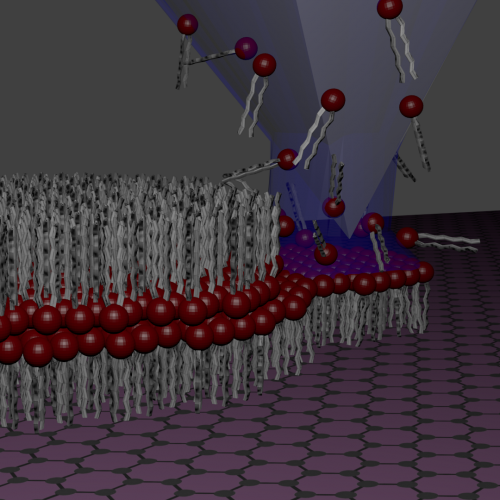Direct 'writing' of artificial cell membranes on graphene

Graphene emerges as a versatile new surface to assemble model cell membranes mimicking those in the human body, with potential for applications in sensors for understanding biological processes, disease detection and drug screening.
Writing in Nature Communications, researchers at The University of Manchester led by Dr Aravind Vijayaraghavan, and Dr Michael Hirtz at the Karlsruhe Institute of Technology (KIT), have demonstrated that membranes can be directly 'written' on to a graphene surface using a technique known as Lipid Dip-Pen Nanolithography (L-DPN).
The human body contains 100 trillion cells, each of which is enveloped in a cell membrane which is essentially a phospholipid bi-layer membrane. These cell membranes have a plethora of proteins, ion channels and other molecules embedded in them, each performing vital functions.
It is essential, therefore, to study and understand these systems, thereby enabling their application in areas such as bio-sensing, bio-catalysis and drug-delivery. Considering that it is difficult to accomplish this by studying live cells inside the human body, scientists have developed model cell membranes on surfaces outside the body, to study the systems and processes under more convenient and accessible conditions.
Dr Vijayaraghavan's team at Manchester and their collaborators at KIT have shown that graphene is an exciting new surface on which to assemble these model membranes, and brings many advantages compared to existing surfaces.
Dr Vijayaraghavan said: "Firstly, the lipids spread uniformly on graphene to form high-quality membranes. Graphene has unique electronic properties; it is a semi-metal with tuneable conductivity.
"When the lipids contain binding sites such as the enzyme called biotin, we show that it actively binds with a protein called streptavidin. Also, when we use charged lipids, there is charge transfer from the lipids into graphene which changes the doping level in graphene. All of these together can be exploited to produce new types of graphene/lipids based bio-sensors."
Dr. Michael Hirtz (KIT) explains the L-DPN technique: "The technique utilizes a very sharp tip with an apex in the range of several nanometers as a means to write lipid membranes onto surfaces in a way similar to what a quill pen does with ink on paper. The small size of the tip and the precision machine controlling it allows of course for much smaller patterns, smaller than cells, and even right down to the nanoscale."
"By employing arrays of these tips multiple different mixtures of lipids can be written in parallel, allowing for sub-cellular sized patterns with diverse chemical composition."
More information: The paper, Multiplexed biomimetic lipid membranes on graphene by dip-pen nanolithography by M. Hirtz, A. Oikonomou, T. Georgiou, H. Fuchs & A. Vijayaraghavan will appear in Nature Communications, DOI: 10.1038/ncomms3591
Journal information: Nature Communications
Provided by University of Manchester




















